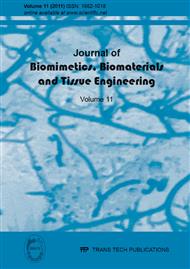[1]
Branham ML, Ross EA. Passive and Facilitated Transport of Cyanocobalamin (Vitamin B12) Across Polymeric Membranes in Artificial Kidneys. J. Biomimetics Bioengn. Tissue Engn. 2011; (10), 7-15.
DOI: 10.4028/www.scientific.net/jbbte.10.7
Google Scholar
[2]
Ameer GA, Grovender EA, Ploegh H, Ting D, Owen WF, Rupnick M, Langer R. A novel immunoadsorption device for removing b2-microglobulin from whole blood. Kidney Intl 2001; 59: 1544–1550.
DOI: 10.1046/j.1523-1755.2001.0590041544.x
Google Scholar
[3]
Bui HH, Schiewe AJ, Grafenstein H, Haworth IS. Structural prediction of peptides binding to MHC class I molecules. Proteins 2006; 63: 43-52.
DOI: 10.1002/prot.20870
Google Scholar
[4]
Cunningham BA, Wang, JL, Berggird, I, Peterson PA. The complete amino acid sequence of beta 2 microglobulin. Biochemistry 1973; 12, 4811-4822.
DOI: 10.1021/bi00748a001
Google Scholar
[5]
Groves ML, Greenberg R. Complete Amino Acid Sequence of Bovine beta 2-Microglobulin. J Biol Chem 1982; 257(5): 2619-2626.
DOI: 10.1016/s0021-9258(18)34969-x
Google Scholar
[6]
Van holder R, Glorieux G, De Smet R, Lameire N. European Uremic Toxin Work Group. New insights in uremic toxins. Kidney Int Suppl 2003; 84: S6– 10.
DOI: 10.1046/j.1523-1755.63.s84.43.x
Google Scholar
[7]
Acchiardo S, Kraus AP Jr, Jennings BR. Beta 2-microglobulin levels in patients with renal insufficiency. Am J Kidney Dis 1989; 13: 70–74.
DOI: 10.1016/s0272-6386(89)80119-2
Google Scholar
[8]
Leypoldt JK, Cheung AK, Deeter RB. Rebound kinetics of beta2-microglobulin after hemodialysis. Kidney Int 1999; 56: 1571–1577.
DOI: 10.1046/j.1523-1755.1999.00669.x
Google Scholar
[9]
Geijyo F, Arakawa M. New Type of Amyloidosis a) β2-Microglobulin and Hemodialysis. Int. Med. 1993; 32(12): 925-927.
DOI: 10.2169/internalmedicine.32.925
Google Scholar
[10]
Winchester JF, Salsberg JA, Levin NW. Beta-2 microglobulin in ESRD: an in-depth review. Adv Ren Replace Ther. 2003; 10: 247–77.
Google Scholar
[11]
Kazama JJ, Maruyama H, Gejyo F. Reduction of circulating beta2-microglobulin level for the treatment of dialysis-related amyloidosis. Nephrol Dial Transplant 2001; 16 [Suppl 4]: 31–35.
DOI: 10.1093/ndt/16.suppl_4.31
Google Scholar
[12]
Naitoh A. Removal of beta-2-microglobulin by diffusion alone is feasible using highly permeable dialysis membranes. ASAIO Trans 1988; 34: 630-634.
Google Scholar
[13]
Lornoy W, Becaus Y, Billiouw JM, Sierens L, Van Malderen P. Remarkable removal of Beta-2-Microglobulin by on-line hemodiafiltration. Am J Nephrol 1998; 18(2): 105-8.
DOI: 10.1159/000013317
Google Scholar
[14]
Mrowka C, Schiffl H. Comparative evaluation of beta 2-microglobulin removal by different hemodialysis membranes: A six-year follow-up. Nephron 1993; 63: 368–369.
Google Scholar
[15]
Tsuchida K, Takemoto Y, Nakamura T. Lixelle adsorbent to remove inflammatory cytokines. Artif Organs 1998; 22: 1064–1069.
DOI: 10.1046/j.1525-1594.1998.06179.x
Google Scholar
[16]
Hoenich NA, Woffindin C, Matthews JN, Goldfinch ME, Turnbull J. Clinical comparison of high flux cellulose acetate and synthetic membranes. Nephrol Dial Transplant 1994; 9: 60–66.
Google Scholar
[17]
Michaels AS. Operating parameters and performance criteria for hemodialyzers and other membrane-separation devices. Trans Am Soc Artif Int Organs 1966; 12: 387–392.
Google Scholar
[18]
Klinke B, Röckel A, Abdelhamid S. Transmembranous transport and adsorption of beta-2-microglobulin during hemodialysis using polysulfone, polyacrylonitrile, polymethyl-methacrylate and cuprammonium rayon membranes. Int J Artif Organs 1989; 12: 697–702.
DOI: 10.1177/039139888901201106
Google Scholar
[19]
Ouseph R, Hutchison CA, Ward RA. Differences in solute removal by two high-flux membranes of nominally similar synthetic polymers. Nephrol Dial Transplant 2008; 23: 1704–1712.
DOI: 10.1093/ndt/gfm916
Google Scholar
[20]
Parzer S, Balcke P, Mannhalter C. Plasma protein adsorption to hemodialysis membranes: Studies in an in vitro model. J. Biomedical Mat. Res 1993; 27: 455–463.
DOI: 10.1002/jbm.820270406
Google Scholar
[21]
Mulzer SR, Brash JL. Identification of plasma proteins adsorbed to hemodialyzers during clinical use. J. Biomedical Mat. Res. 1989; 23 (12): 483–1504.
DOI: 10.1002/jbm.820231210
Google Scholar
[22]
Cheung AK. Biocompatibility of hemodialysis membranes. Nephrol 1990; 1: 150–61.
Google Scholar
[23]
Tsuchida K, Takemoto Y, Sugimura K. Adsorption of endotoxin by beta(2)-microglobulin adsorbent column (Lixelle): The new approach for endotoxinemia. Ther. Apher. 6: 116-118.
DOI: 10.1046/j.1526-0968.2002.00412.x
Google Scholar
[24]
Davankov V, Pavlovaa L, Tsyurupa M, Bradyb J, Balsamo M, Yousha E. Polymeric adsorbent for removing toxic proteins from blood of patients with kidney failure. J. Chromatogr. B Biomed. Sci. Appl. 2000; 739: 73-80.
DOI: 10.1016/s0378-4347(99)00554-x
Google Scholar
[25]
Kim M, Sungsoo K, Eun-Kyung M, Minkoo A, Jeong-Hyun C, Seung RP, Yoon-Sik Lee. Seed-Conjugated Polymer Bead for β2-Microglobulin Removal at Neutral pH. J. Microbiol. Biotechnol. 2009; 19 (9): 960–965.
DOI: 10.4014/jmb.0812.688
Google Scholar
[26]
Grovender EA, Kellogg B, Singh J, Blom D, Ploegh H, Wittrup KD, Langer R, Ameer GA. Single-chain antibody fragment-based adsorbent for the extracorporeal removal of β2-microglobulin. Kidney Int. 2004; 65: 310-322.
DOI: 10.1111/j.1523-1755.2004.00377.x
Google Scholar


